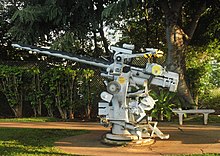| 3-inch/50 caliber gun (Mk 22) | |
|---|---|
 Mark 22 3"/50 cal gun | |
| Type | Naval gun |
| Place of origin | United States |
| Service history | |
| In service | 1900–1990 (US Navy) |
| Used by | US Navy |
| Production history | |
| Designed |
|
| Produced | 1900–1948 |
| Variants | Marks 2, 3, 5, 6, 8, 10, 17, 18, 19, 20, 21, and 22 |
| Specifications | |
| Mass |
|
| Length |
|
| Barrel length |
|
| Shell | complete round: 24 lb (11 kg); projectile weight: 13 lb (5.9 kg) projectile types: AP, AA (with VT proximity fuze), HE, Illumination[1] |
| Caliber | 3-inch (76 mm) |
| Elevation |
|
| Traverse | 360° |
| Rate of fire |
|
| Muzzle velocity | 2,700 ft/s (820 m/s) |
| Maximum firing range |
|
| Sights | Peep-site and Optical telescope |
The 3-inch/50-caliber gun (spoken "three-inch fifty-caliber") in United States naval gun terminology indicates the gun fired a projectile 3 inches (76 mm) in diameter, and the barrel was 50 calibers long (barrel length is 3 in × 50 = 150 in or 3.8 m). Different guns (identified by Mark numbers) of this caliber were used by the U.S. Navy and U.S. Coast Guard from 1900 through to 1990 on a variety of combatant and transport ship classes.[3]
The gun is still in use with the Spanish Navy on Serviola-class patrol boats.